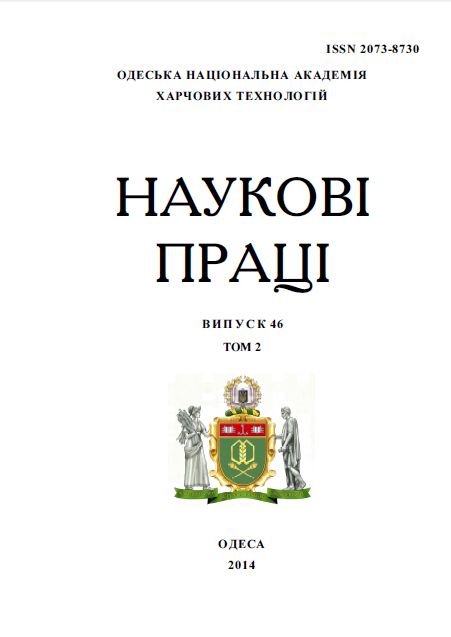EFECT OF SMOKING ON THE ACCUMULATION OF POLYCYCLIC AROMATIC HIDROCARBONS, IN M. LONGISIMUS DORSI FROM PIGS AND POSSIBILITIES FOR REDUCING THEIR CONTENT
Kulcsszavak:
meat, polycyclic aromatic hydrocarbons (PAH), benzo (a) pyrene (BaP).Absztrakt
This study deals with the effect of smoking process and the accumulation of toxic polycyclic aromatic hydrocarbons in Musculus Longissimus dorsi from pigs and studies the possibilities to reduce their content. The studies were conducted on two samples boiled-smoked fillet – one salted with brine and added protein
coating, whereas the second one salted with brine and added ascorbic acid.
Qualitative identification and quantification of polycyclic aromatic hydrocarbons is done by gas hromotograph Hewlett Packard 5890 with LG 85 B spectrophotometric detector. It was found that the use of protein
coatings, significantly reduces the amount of polycyclic aromatic hydrocarbons in the smoking of Musculus Longissimus dorsi from pigs. The addition of ascorbic acid in conjunction with protein salting coatings technology represents a significant option for reducing the content of the benzo(a)pyrene , which contributes to the safety in the final products. In studies of the samples of proteins and ascorbic acid, the inner layers i.e the muscle tissue was found to contain significantly less amount of benzo(a)pyrene (1,75 ± 0,06 μ/kg) compared with the values found in the surface layers (2,31 ± 0,02 μg/kg).
Hivatkozások
GEORGIEVA P., S., TODORINOV , ST. TANCEV, Mathematical and Statistical methods in technological research, Agricultural Science, 1989, 25, 1, – P. 100 – 109.
CHAO A, THUM MJ, CONNELL CJ, MC CULLUNGH ML, JACOBS EJ, FLANDERS WD, RODRIGEZC, SINHA R, CALLE EE. (2005): "Meat consumption and risk of colorectal cancer." Journal of the American Medical Association, – P. 172-182.
FARHADIN A., JINAP S., FARIDAH A., ZAIDUL I. (2012): Effects of marinating on the formation of polycyclic aromatic hydrocarbons (benzo[a]pyrene, benzo[b]fluoranthene and fluoranthene) in grilled beef
meat. Food Control, V.28 (2), – P. 420-425.
HITZEL А., POHMANN M., SCHWAGELE F., SPEER K., JIRA W. (2013): Polycyclic aromatic hydrocarbons (PAH) and phenolic substances in meat products smoked with different types of wood and smoking spices. Food Chemistry, V.139, (1–4), – P. 955-962.
FALCO G., DOMINGO J.L., LLOBET J.M., TEIXIDO A., CASAS C., & MULLER L. (2003): PAHs in Foods: Human Exposure throught the Diet in Catalonia, Spain. Journal of Food Protection. 66(12), – P.2325
– 2331.
HIGGINBOTHAM S., ROMAKRISHNA N., JOHANSON S.,ROGAN E., CAVALIERI E. (1993): Tumorinitiating activity and carcinogenicity of dibenzo(a)pyrene versus 7,12-dimethylbenz/a/antracence and benzo/a/-pyrene at low-doses in mouse skin. Carcinogenesis, 14, – P. 875 – 878.
JIRA W., (2005): Benzo(a)pyren in geraucherten Fleischerzeugnissen – Leitsubstanz fur das durh Polycyclische aromatische Kohlenwasserstoffe bedingte kanzerogene Potential. Fleischwirtschaft, 85 (9), – P. 112 – 116.
JANOSZKA B., (2011): HPLC-fluorescence analysis of polycyclic aromatic hydrocarbons (PAHs) in pork meat and its gravy fried without additives and in the presence of onion and garlic. Food Chemistry, V.126
(3), – P. 1344-1353.
NAWROT P.S.,VAVASOUR E.J., GRANT D.L., (1999): Food irradiation, heat treatment, and related processing techniques: safety evaluation. In: Van der Heijden K., Younes M., Fishbein L., Miller S., International
Food Safety Handbook, – P. 306 – 8.
PAVANELLO S., PULLIERO A., CLONFERO E. (2008): Influence of GSTM1 null and low repair XPC PAT+ on anti-B[a]PDE-DNA adduct in mononuclear white blood cells of subjects low exposed to PAHs
through smoking and diet. Mutation Research / Fundamental and Molecular Mechanisms of Mutagenesis, V.638 (1–2), – P. 195-204.

